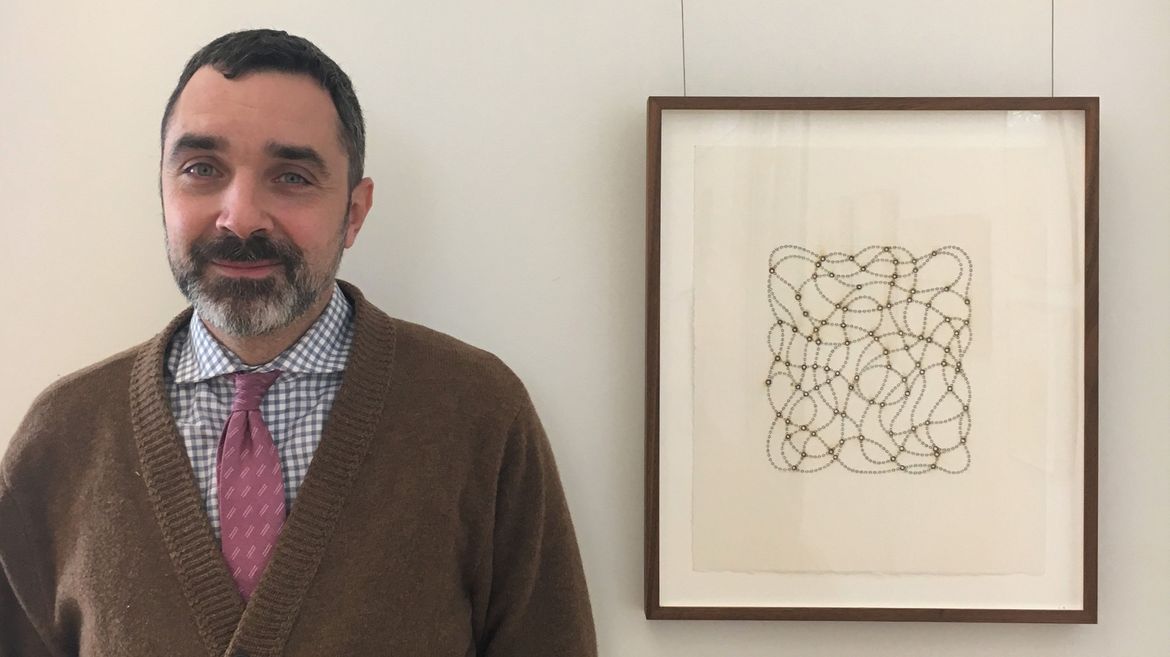Thomas Cattoi is a member of the GTU's core doctoral faculty and Associate Professor of Christology and Cultures at Jesuit School of Theology of Santa Clara University, where he also holds the ...
Burnt Letters
The Fall 2019 exhibition at the GTU’s Doug Adams Gallery, Beyond Words: Art Inspired by Sacred Texts, features the work of four artists who explore through creative expression stories and themes from the sacred texts of some of the world’s religious traditions. To accompany the exhibition, the Center for the Arts & Religion invited GTU scholars to use a work from the exhibition as a prompt for their writing. The exhibition catalog for Beyond Words includes five essays by GTU faculty and students, each reflecting on one of the exhibited works.
The excerpt below is taken from “A Reflection on ‘Rosary No. 1’ by Meg Hitchcock,” by Dr. Thomas Cattoi, of the GTU and Jesuit School of Theology of Santa Clara University. To read Dr. Cattoi’s full essay, and the fascinating work of his fellow essayists, contact CARe@gtu.edu to order a catalog ($25+tax), or become a member of CARe and receive a catalog as a thank-you gift!
Burnt Letters
by Dr. Thomas Cattoi
In "Rosary No. 1," contemporary artist Meg Hitchcock strings together letters cut from the Bible and burnt with Tibetan incense, coming together to produce a tangled maze of white dots without beginning or end, or even an apparent purpose. The words of Scripture are supposed to convey the word of God, but here they are barely visible, effaced by the incense and tied up without any direction. We tend to think of the Old and the New Testament as a story -- something that has a beginning, a development, and an end -- but here we cannot trace any narrative. We just rest in front of this directionless tangle, almost waiting for some instruction or voiceover -- what do we do with this image? What is it trying to tell us?
Many contemporary Christians find it difficult to accept at face value the metaphysical truths that undergird the Christian narrative, but may still find solace in Christian imagery and the Christian story. Others, after they encounter Eastern traditions such as Buddhism or Hinduism, come to rethink Christianity in light of the teachings of these traditions. Some Christians continue to find sustenance in the traditional Christian vision; others do not, and create their own spiritual collages, which provide them with a framework for daily life. This work of art, perhaps, is one such collage- an iconic representation of the reality of multiple religious belonging that is becoming increasingly common in the West.
In the Book of Exodus (3, 1-21), Moses sees a bush that is enveloped by fire, but is not consumed. Here, the letters of Scripture are singed by a fire that comes from the East and leaves them scattered and seemingly unintelligible. The idea of Tibetan incense burning the letters of the Christian Scriptures seems to me an apt metaphor of the encounter between Buddhist and Christian metanarratives that is reshaping our religious landscape. The stories - the letters - are still there, but somehow they no longer fall easily into their old place; they are scattered, loose, and more difficult to decipher. Yet, they linger, and we do not really want to let go of them. There may no longer be a clear explanation for the world’s suffering, or a clear goal towards which we are moving, but we are still living in a world that is shaped by the Christian story. Perhaps Hitchcock’s image portrays the rosary for an age of multiple religious belonging; one where fragments of the old tradition are still present, but after coming in contact with other ways of making sense of the world, they have become difficult to read, and apparently lack direction or purpose. Alas, it often seems that all we have is a tangle of letters; but like the knot of co-dependent origination, this image reminds us that the universe sustains us, even if often this appears to take place in ways that are beyond our understanding


